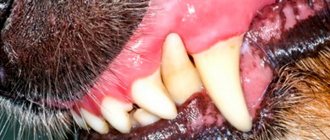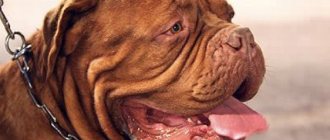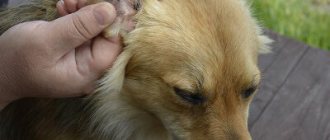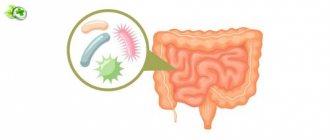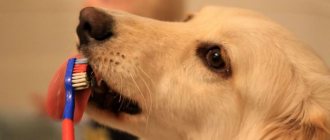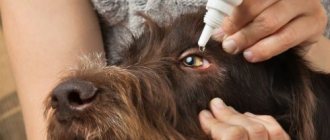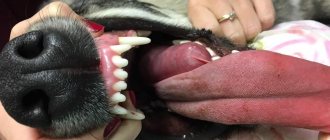Answers:
Elena
A dog's nose is the main sign of health problems. Therefore, if the nose is not wet and cold, like a healthy dog, this should alert you. A dry, hot, and sometimes cracked nose should alert the owner - this is a symptom of the onset of the disease. True, a dog may have a warm nose during play or immediately after sleep. But still be observant in order to catch a possible disease in time. If your dog returns home with his nose stained with clay or soil, remove the dirt with a damp soft cloth. Dogs also have a simple runny nose as a result of hypothermia and inhalation of irritating substances. The nasal passages of dogs are very narrow, they have a lot of folds, so medicine in the form of aerosols is more effective, but aerosols are unpleasant for dogs, so it is better to use children's drops for runny nose in liquid oil. Avoid using vasoconstrictor ephedrine-like drugs such as Sanorin and Naphthyzin to treat a dog’s runny nose. It is very dangerous. Thick, greenish discharge from the nose, accompanied by the formation of thick crusts and roughening of the skin of the nasal mucosa, is often an indicator of plague. Especially if greenish purulent discharge from the eyes is also observed. It is clear that the help of a doctor is needed here. The resulting “crusts” can be removed by first softening them with petroleum jelly or glycerin. Remove secretions from the nasal passages using tightly twisted cotton wool flagella, also moistening them with Vaseline or glycerin. Runny nose in dogs In dogs, the most common causes of rhinitis as an independent disease are sudden cooling of the body, rapid transitions from heat to cold or vice versa. This type of rhinitis usually occurs in spring or autumn.
Freddy Krueger
Is your nose wet?
Natalia Grozenok
I treated with drops... there are special drops for dogs' noses
A Past And Future Secret
A veterinarian. And the sooner the better. A runny nose can be either rhinitis or a symptom of much more serious illnesses. Such, for example, as plague or adenovirus.
Did you take your temperature?
Khabibullina Natalia
What other symptoms does the dog have, temperature? Is she coughing? A runny nose can be a sign of adenovirus. There is also an assumption that something got into the nose, festered and now the process of rejection is underway. In any case, do not do anything on your own; it is better to consult a veterinarian.
Olga Zayarnova
Dogs very rarely have a runny nose just like that... More often it is plague or adenoviral infection... don’t delay and go to the vet.
There are many diseases in dogs whose symptoms include a runny nose, such as allergies or various tumors. The method of treating a runny nose depends on the specific cause of its occurrence. Before starting treatment, it is necessary to establish an accurate diagnosis of the disease.
Diagnosis
A dog's runny nose can indicate a serious illness. To establish a diagnosis and begin treatment, you need to analyze nasal discharge. If the discharge is clear, there may be a foreign object in the nasal passage; such discharge may also indicate an allergy. If the discharge is quite thick, the dog most likely has a respiratory infection.
Allergy treatment
The most common cause of runny nose in dogs is allergies to pollen, dust, chemicals, etc. Like people, dogs are often susceptible to such ailments. Additional evidence of an allergy can include discharge from the eyes, frequent sneezing and coughing, and itchy skin. To begin treatment of a runny nose in this case, it is necessary, first of all, to accurately identify the allergen and not allow the dog near it. For allergies, veterinarians often prescribe antihistamines, such as chlorpheniramine or diphenhydramine. Before using any medications, consult your veterinarian; their effectiveness depends on the specific case and the dog itself.
In some cases, your veterinarian may prescribe corticosteroid medications.
Treatment for infection
If the cause of a runny nose is a viral infection (cold), as indicated by yellow and thick nasal discharge, treatment with antibiotics is necessary. Infection in dogs can be fungal, viral or bacterial. Depending on its specific type, certain drugs are used.
If purulent discharge is present, a diagnosis of distemper may be made. This is a deadly disease that requires immediate treatment. It can also be treated with antibiotics, but other methods, such as fluid therapy, may be needed.
Pink nasal discharge indicates a fungal infection. It is difficult to treat because... reproduces very quickly. However, the use of antifungicides can help get rid of the disease.
The course of treatment for viral diseases lasts about 2 weeks, for fungal diseases - a month or more.
Foreign objects
A clear sign that a foreign object has entered the dog's nose is discharge from only one nostril. In addition, nosebleeds may indicate damage to the respiratory tract. Try to remove the object yourself, for example, using tweezers. If this fails, contact your veterinarian.
Surgical intervention
If your dog's runny nose is chronic and cannot be treated, it most likely has a tumor or polyps. In this case, the only treatment option is surgery.
How to treat a runny nose in a dog
Answers:
Polyakova
We need to determine the cause, maybe it’s an allergy?
Maria Eremeeva
We washed it with furacelin, and also bought special drops from a pet store. Come there, they will advise you on drops for both the breed and the weight of the dog. By the way, you don't have to worry too much because it's a common flower allergy in dogs. They feel spring earlier than people, so you can also buy some herbal allergy pills
Levi
Depending on the diagnosis.
Alenka Alenkina
Dogs don't have allergies!!! !
Most likely, it is a viral disease; there is no need to treat it like a runny nose, it should be a comprehensive treatment prescribed by a doctor
Anastasia
You can use baby drops, and furatsilin will do
Alexander Rura
if viral rhinitis, then rinse with furatsilin and antibiotics biomycin 25 mg/kg body weight for a course of 5 days
Pskov woman
Marianna wrote it correctly. This is most likely a viral infection (the so-called canine flu). Depending on the dog’s immunity, it occurs in varying degrees of severity. Last spring our whole group of dogs got sick. Someone sneezed for a couple of days, and some ended up on a drip... But as it turned out, this rubbish also creates complications... It’s better not to self-medicate, but to visit a veterinary clinic, I think... I read about an allergy supplement... Then give the dog an antihistamine (such as Tavigil) and watch his nose. If the snot goes away, then your diagnosis is allergy... Look for the allergen... and eliminate...
My Shar Pei has a runny nose, how to treat it?
Answers:
Fluffy Slipper
snot in dogs is most likely a sign of a viral disease, and not a runny nose... they don’t have a runny nose... so the sooner you see a doctor, the better for your dog!
Olga
Runny nose in dogs In dogs, the most common causes of rhinitis as an independent disease are sudden cooling of the body, rapid transitions from heat to cold or vice versa. This type of rhinitis usually occurs in spring or autumn. Rhinitis in dogs, as in cats, can occur after inhaling irritating substances or hot air, smoke during forests or other fires. And another reason for its appearance is when foreign bodies appear in the nasal cavity: spikelets or awns of plants. A sick dog often sneezes, rubs its nose with its front paws, and licks its lips. Then nasal discharge appears, first liquid and transparent, then thick, and in infectious diseases - purulent. These secretions dry on the wings of the nose and form crusts. If the discharge is profuse, the dog's breathing is labored and he wheezes. When complete blockage of the nasal openings occurs: the discharge from the nostrils and the crust on the wings of the nose dry out, the dog begins to breathe through the mouth. With rhinitis as an independent disease, the dog’s general condition does not change, its appetite is normal. There are two forms of rhinitis in dogs: acute and chronic. Acute rhinitis usually proceeds well and ends with recovery within five to seven days. However, if measures are not taken to eliminate the cause of the disease, acute rhinitis becomes chronic. How long rhinitis that occurs as a complication of a disease will last depends on the course of this disease. A runny nose may not stop for months or even years. Treatment of acute rhinitis. If there is heavy discharge from the nose, the nostrils are cleaned and the crusts are removed several times a day, after softening them with a 3% solution of hydrogen peroxide. To prevent crusts from appearing, the circumference of the nasal openings is lubricated with Vaseline. 3 - 4 times a day for 10 - 15 minutes insert pieces of cotton wool moistened with fresh onion juice into the nostrils. The nose area is warmed with hot sand poured into a small bag 3-4 times a day, or an inhalation method of treatment is used: the dog inhales potato steam. You can lubricate the nasal cavity several times a day with 1-2% menthol ointment or boric acid, 2 grams, with glycerin, 50 grams. For irrigation of the nasal mucosa, a 0.5% tannin solution and a 1% soda solution are recommended. You can also carefully blow streptocide powder into your nose. If you have a runny nose with thick discharge, wash your nose with boiled beetroot juice. For chronic rhinitis, the treatment is the same. However, with this form of the disease, constant nasal discharge causes skin irritation and it becomes weeping. Therefore, it must be dried. A powder of white streptocide is recommended, which is used several times a day. Infectious rhinitis is treated simultaneously with the underlying disease, 5-10 drops of galazolin are instilled into the nose, into each nostril. To increase the body's defenses, general ultraviolet irradiation should be carried out. Thymogen is also used, once a day for ten days it is instilled into the nose: for cats 1 - 2 drops, for dogs - from 1 to 8 drops, depending on weight, for a dog weighing 9 - 10 kilograms - 2-3 drops.
Diseases and symptoms
A common question asked by pet owners is what kind of rhinitis does the dog suffer from? After all, on the vastness of the World Wide Web, information is always ambiguous. We will try to answer this question and sort out all the information.
Rhinitis is classified according to several indicators:
By origin
- primary – manifests itself;
- secondary – is a consequence of another disease and accompanies it.
According to the method of flow
- acute – vivid clinical picture, rapid progression;
- chronic – smoothed symptoms, long-term course.
By type of inflammatory process
Catarrhal (mucous) rhinitis is accompanied by the release of serous, serous-mucosal and serous-purulent exudate.
Symptoms: with primary catarrhal rhinitis, the dog’s general condition initially remains virtually unchanged, body temperature is within normal limits, and the appetite is good. Dogs sneeze, snort, grunt, cough, and try in every possible way to rub their noses against surrounding objects.
Initially, the discharge (or snot) is serous, after a few days it may turn into serous-purulent exudate. Nasal discharge dries out, forming crusts. Regional lymph nodes, namely the submandibular and retropharyngeal lymph nodes, are enlarged in size, their temperature is increased relative to other tissues, and they are painful on palpation.
The mucous membrane is reddened and swollen - this causes difficulty breathing. With severe damage to the nasal passages, the dog breathes through the mouth. In some cases, conjunctivitis may develop, and lacrimation from the eyes may occur.
Follicular (vesicular) rhinitis in animals is caused by streptococcal infection.
Follicular rhinitis most often affects horses, dogs less often.
Symptoms: in the first days the pet experiences weakness and fever. Appetite is weak. An infection that penetrates into the nasal mucosa causes irritation; it becomes hyperemic and swollen.
Catarrhal inflammation develops. After a short period of time (2-4 days), gray-yellow blisters filled with catarrhal-purulent exudate appear. The bubbles are located close to each other, gradually increase in size, and then merge and burst, leaving wounds (erosions) in place.
Bubbles can appear not only on the mucous membrane, but also on the mirror, wings of the nose, and upper lip. All this is accompanied by strong discharge from the nose. The lymph nodes are enlarged, painful on palpation, compacted, and the temperature is elevated. Follicular rhinitis lasts 16–21 days and ends with complete recovery.
Croupous (fibrinous) rhinitis - accompanied by the release of fibrinous exudate.
Symptoms: the animal is depressed, refuses to feed, lies down all the time. The temperature can rise to 41.5 C. The discharge is yellow, viscous, mucus mixed with fibrin and blood. The nasal mucosa is hyperemic, swollen, a coating of fibrin films and small ulcerations are clearly visible.
Breathing is heavy, inhalation is longer than normal, the dog wheezes, trying to stretch his head as far as possible. The submandibular lymph nodes are enlarged.
With timely treatment, recovery occurs in 1.5 - 2 weeks. In the absence of proper treatment, the animal may die due to asphyxia.
Fibrinous films should not be torn/removed, as this will open access to microorganisms in the tissue, which will cause complications.
Purulent rhinitis is manifested by a characteristic symptom - purulent discharge from the nose. Snot of green, dark brown, green-yellow, white-yellow color (pus). Body temperature is elevated, appetite is weak or absent altogether. Severe weakness, with chronic purulent diseases (and not only) the animal noticeably loses weight.
The mucous membrane is pale pink in color, ulcerations appear, which immediately become covered with a crust. The dog has a cough, often snorts, and tries in every possible way to clear the nasal passage.
Self-medication can lead to exacerbation of purulent rhinitis. A doctor's consultation is required.
In addition to the 4 main types of rhinitis described above, there are several more types.
Allergic rhinitis is an inflammation that develops as a result of the action of various allergens. Characteristic signs are frequent sneezing, profuse nasal discharge and impaired nasal breathing.
This rhinitis can be provoked by strong odors, pollen, dust, fungal spores, cold/hot air. Transparent color discharge. Such a runny nose can occur seasonally (for example, during flowering plants) or year-round - chronic rhinitis.
Vasomotor rhinitis is one of the types of rhinitis, which is caused by a violation of the tone of blood vessels. It manifests itself as a small discharge of colorless mucus. The mucous membrane thickens and becomes pale. The appetite is good, the general condition of the animal is normal. Body temperature is not elevated. Dangerous for pregnant bitches (due to lack of oxygen, puppies may develop pathologies).
Viral rhinitis in dogs is rarely diagnosed in veterinary medicine; more often this diagnosis is given to humans.
How to treat a runny nose in a dog, please tell me..
Answers:
La Mur
Anandin - intranasal, i.e. drip into the nose and eyes. If it doesn't help, then run to the vet.
selena mystery of the night
inject fosprenil and gamavit once a day, 0.1 ml per 1 kg of weight. drip maxidin 0.015% or anandin into the nose. Lubricate your nose with oxolinic ointment. and solder with Vet 1.1.
maritime
First you need to eliminate the causes of rhinitis. it can occur due to inhalation of air containing dust, corrosive gases, mold, due to drafts, dampness and hypothermia, BUT it can also appear as a consequence of inadequate feeding, in particular vitamin deficiency. A. and be a symptom of infectious diseases!!! and here we also need to treat the underlying disease! well, to treat rhinitis, the nasal mucosa is irrigated with 0.25% novocaine solution, 2-3% boric acid solution, 3-5% baking soda solution, dogs can be instilled into the nostrils with 1% menthol solution in vegetable oil or fish oil. if there is an increase in temperature, then antibiotics are prescribed, but in this case it is definitely better to consult a doctor.
As you know, dogs are very similar to their owners. Including diseases. Dogs can develop snot just as often as humans. A dog’s runny nose is aggravated by the fact that the dog loses the activity of its main sense – smell. This makes the dog start to worry. If you notice that your dog has snot, you need to try to help your pet as quickly as possible.
What can cause constant sneezing and snot in dogs?
If a dog sneezes and snorts several times a day, and this happens during a walk, when new smells appear, then this is normal. If the dog begins to snort, sneeze and breathe heavily due to snot in the nose, then you need to immediately pay attention to this factor.
An allergic reaction in a dog - snot and sneezes, what to do?
Symptoms of a pet's allergic reaction include:
- constant sneezing;
- cough;
- hissing;
- watery eyes;
- swollen nose;
- whitish discharge from the nose;
- constant scratching (itching);
- the appearance of skin irritation.
Allergies can appear from too strong odors of household chemicals, perfume, cigarette smell, new food, mold (fungus), dust particles.
It will be better to introduce new foods into your pet’s diet if we prepare them for our dogs with our own hands.
Important!
If your dog begins to snort and sneeze frequently in your apartment, pay attention to where and when this happens. This will help you quickly find the cause of the allergy.
Foreign body in the nose
If your dog suddenly begins to snort furiously, rub his nose on objects and shake his head, then it is likely that a foreign body has entered his nose.
Using tweezers, try to pull out the interfering object. If this doesn't work, go to the doctor immediately.
Getting injured
There are times when, during active play, an animal hits something hard, and the owner does not notice it.
Important!
If you notice blood or bloody discharge from your dog's nose, contact your veterinarian immediately.
My dog has a runny nose and is sneezing, how to treat it?
In animals, even hardy or large breeds that constantly live at home, their immunity weakens.
Therefore, if you walk your dog in frosty weather for a long time, then take care of the equipment.
Suits are made for all breeds. If after a long walk the dog has a runny nose and sneezing for two days, with crusts forming on the wings of the nose, then he has caught a cold.
If after 5 days the animal does not stop sneezing, and the snot becomes yellow-greenish and thick, you need to give medicine, since this is an infection called rhinitis.
If the animal is coughing and breathing heavily, this may be the onset of pneumonia.
Advice!
Crusts from the nose are removed with a peroxide solution or warm water, and then the nose is lubricated with Vaseline or baby fat cream.
Infectious diseases
Canine distemper (Carré disease)
At first, it manifests itself not only in the form of a runny nose and cough, but also sudden lethargy, the pet’s refusal to eat, increased water consumption, discharge from the eyes and vomiting.
Signs of a disease such as adenovirus are purulent nasal discharge, crusts, and watery eyes.
Important!
If an animal does not eat for 24 hours, lies down, and vomits, then it is necessary to contact the clinic urgently!
Tumors
If a situation occurs where the animal is not injured, but is actively trying to get rid of something in the nose
, then these
could be tumors or polyps
. If there is something wrong with the animal, and you cannot understand what exactly, take it to the doctor.
Why does a dog have snot?
- One of the main reasons for the appearance of discharge is allergies. Allergic rhinitis can be triggered by anything - plant pollen, new types of food, a collar, cosmetic care products, insect bites. In this case, the snot is usually clear and watery. Allergic rhinitis also causes watery eyes, sneezing, itching, and even difficulty breathing.
- Often dogs inhale various objects through their noses, which successfully get stuck in the nasal passages. In this case, not only mucus may be released, but also blood.
- Another common cause of snot is a viral infection. A dog catches a cold and gets sick just like a person.
- Hot air from a hair dryer, acrid smoke, toxic odor - all this can cause increased mucus secretion.
- Snot appears after long winter walks simply because the dog is cold.
Some dog breeds (for example, pugs, bulldogs, Pekingese) have naturally narrow nasal passages. This natural defect often prevents them from breathing through their nose, and the dog is forced to breathe through their mouth. At the same time, snot flows, often foamy. If desired, this situation can be corrected surgically. In any case, the owners of these dogs should be more careful about the health of their pets and immediately begin treatment for a runny nose. If this is not done, a common symptom can develop into a chronic disease.
How to treat a runny nose in a dog
Before treating a runny nose itself, it is very important to find out the cause of its occurrence. If your dog sneezes frequently and not only mucus but also blood comes out of his nose, then most likely foreign objects are stuck in the nasal passage. These can be thorns, plant seeds, twigs. Carefully examine the animal's nose and, if possible, remove the foreign object using tweezers. If this fails, be sure to take the dog to the veterinarian, otherwise an inflammatory process may begin.
If the cause of a runny nose is an allergy, you need to try to identify the allergen. Remove from use anything that could cause an allergy in the dog - new food, a new collar, a food bowl. If possible, reduce your walking time and avoid walking in the grass. For severe runny nose, watery eyes and sneezing, you can give the animal an antihistamine (Zodak, Ketotifen, Diazolin, Suprastin). The dose should be calculated taking into account the weight of the animal.
Very often, with a runny nose (whatever its nature), crusts form in the dog’s nose. They interfere with the normal passage of air, the dog often sneezes, breathes through its mouth, and tries to clear the nasal passages. In this case, you need to drop a few drops of hydrogen peroxide into each nostril. After a while, when the crusts soften, they need to be pulled out with cotton swabs. If you have a runny nose, this cleaning should be done 1-2 times a day.
Often, when a dog has a runny nose, his nose becomes cracked and hurts. Lubricate it with nourishing cream, Vaseline or olive oil. This will heal the cracks and prevent new ones from appearing.
Important! When treating dogs, human vasoconstrictor drops and nasal sprays should not be used. It may be dangerous.
Diagnosis of an animal
First of all, it is important for the owner to make sure that the cause of purulent nasal discharge in the pet is sinusitis, and not an infectious disease such as canine distemper. A viral infection, as a rule, is accompanied not only by symptoms of purulent sinusitis, but also by diarrhea, vomiting, and severe dehydration. If such a clinical picture is present, the owner should immediately seek qualified help.
After collecting an anamnesis and conducting a general clinical examination, the veterinary specialist prescribes a series of studies. First of all, a laboratory study of the washout from the nasal mucosa is carried out. Bacteriological analysis allows you to determine the causative agent of the infection and select the most effective antibacterial drug.
Clinical blood examination allows you to clarify the diagnosis. With sinusitis, leukocytosis and an increased content of lymphocytes are observed.
X-ray examination helps to reliably judge inflammation of the maxillary sinuses in an animal. X-rays are taken in frontal and lateral projections, the animal’s mouth should be open. In the image, an experienced veterinary radiologist will see areas of darkening, which indicate that the nasal sinuses are filled with purulent contents.
An X-ray examination will detect a foreign body in the nasal cavity, an anomaly in the development of the skull, neoplasms, and polyps.
Differential diagnosis is carried out primarily in relation to infectious diseases - canine distemper, adenovirus infection. Sinusitis, frontal sinusitis, and neoplastic causes of sinusitis are excluded.
How to treat colds
If the cause of your dog’s snot is a cold and hypothermia, the principle of treatment changes. Here are some effective ways to quickly and painlessly get rid of a runny nose in a dog.
- Dissolve the streptocide tablet in a small amount of water. After this, using a pipette, drop 2 drops of the prepared solution into each nostril of the dog. This will ease your pet's condition if the cause of snot is a viral cold.
- Another excellent remedy for a runny nose is onion juice. Fresh onions need to be chopped and juice squeezed out of them. It is best to soak cotton swabs in this juice and place them in the dog’s nose. However, not every dog can withstand this procedure, so in most cases it is easier to drop a few drops of onion juice diluted in half with water into each nostril.
- You can also drop beetroot juice into the animal's nose. It is diluted with boiled water and instilled into each nostril 3-4 times a day.
- If the snot is thick, yellow or green, you can treat the dog with Pinosol. Place 2-3 drops into each nostril several times a day and very soon your dog will come to his senses.
- Another excellent remedy for fighting snot is Derinat nasal drops. This medicine copes well with bacteria, viruses and infection.
- Many dog breeders actively use vitamin A in liquid form to combat the common cold. It is sold in pharmacies in ampoules. It not only suppresses the virus, but also softens and moisturizes the nasal mucosa.
If your dog has a cold, you need to make sure the room is cool. Take care of the air humidity, because dry air dries out the mucous membrane, which leads to the formation of crusts. Let your dog drink more. If you add a spoonful of honey to your pet's water, she will happily drink the whole bowl. After all, drinking plenty of fluids helps eliminate the virus from the body as quickly as possible. In addition, honey is useful for strengthening the immune system.
When dealing with snot on your own, it is very important to monitor the general health of the dog. If your pet has lost its appetite, if it is weak and apathetic, you should urgently consult a doctor. Sometimes snot can be a symptom of a serious illness, such as plague or tuberculosis. You can treat your dog for snot only if nothing else bothers him other than a runny nose. Take care of your pet and respond to its symptoms in a timely manner.
Symptoms You Shouldn't Ignore
In some cases, it is impossible to do without the help of a veterinarian and treatment. If the discharge does not stop, and your pet becomes lethargic or has a fever, you should consult a doctor. After the examination, he will tell you what to do and why the dog has snot; is it an independent illness or a symptom of a dangerous disease.
Neoplasms in the nasal passages
When there is a tumor in the dog's nose, there is often pus in the discharge, and blood streaks are also noticeable. In this case, the animal will feel discomfort and pain. It whines and touches its nose with its paws, trying to provide itself with air.
Foreign bodies
What to do if your dog has a runny nose is not always immediately clear. First of all, you need to make sure that there is no foreign object in her nose:
- Usually in this case, discharge appears only from one nostril;
- traces of blood may be visible;
- the dog will feel that something is bothering him, trying to reach the object with his paws.
Note! Even a thread, and even more so a part of a children's construction set, will cause great discomfort to the dog.
You can shine a flashlight into your nose and, if you are confident in your abilities, remove the object with tweezers. You need to act very carefully so as not to scratch the mucous membrane. If the owner doubts that he will succeed, he needs to go to a dog clinic.
You can suspect that your puppy's snot appears as a result of a foreign body if it begins to bother you almost immediately after a walk. An inexperienced animal sniffs everything in its path, so, for example, a small stone or a piece of paper gets into its nose.
Puppy behavior on the street
Infectious diseases
Dogs, like people, are affected by viruses and bacteria. In this case, rhinitis is one of the main symptoms. When attacked by viruses, nasal discharge is liquid and clear. But if the dog cannot recover on his own, they become yellow or green and thicken. In this case, the dog usually has a stuffy nose and breathes through its mouth most of the time. If your pet is left untreated, crusts may form. They are clearly visible on the dog's nose. The animal may refuse to eat, be sad and lethargic, and spend most of its time in its corner on the bedding.
Important! If your dog has a fever and is unable to breathe through his nose, the doctor will tell you what to do after examination and the necessary tests. Perhaps rinsing with Miramistin will be enough, and the dog will get better. But you need to remember that self-medication can be harmful to your pet’s health.
Parasites
Various parasites can cause a severe runny nose:
- worms;
- fleas;
- ticks.
They poison the body, killing its immune system. In addition to mucous discharge, other symptoms appear, in particular, body temperature may rise and a rash may appear on the skin. Sometimes parasites get into the nose, causing breathing problems and causing the formation of snot.
Deformations in the structure of the nasal passages
Irregular structure of the nasal passages can be congenital. The animal can wheeze, grunt and even quack. The dog also breathes frequently through his mouth. This is not life-threatening, but provokes frequent colds. Therefore, such pets need to be taken care of, constantly monitoring their condition.
Note! Also, deformation often occurs after fights or accidents. It is necessary to be observed by a specialist to eliminate dangerous consequences.
Tumors, polyps
Benign tumors and polyps do not threaten the pet’s life and do not affect its quality. But they cause inconvenience if they narrow the nasal passages and cause drying of the mucous membrane. Then discharge appears, and if the growths are injured, blood is found in the snot. It is possible to get rid of them only through surgery.
Allergy
Some pets react by producing mucous discharge to dust or pollen. Allergies are also sometimes observed to animal care products, shampoos or sprays.
In addition to a runny nose, the following symptoms are usually observed:
- the dog's eyes water and become red;
- the dog sneezes;
- cough appears;
- the mucous membrane swells;
- sometimes diarrhea begins.
Note! You need to immediately identify the allergen and get rid of it so as not to worsen the situation. Without this, treatment will be pointless.
Fungal infection
If a dog has a fungal infection, the discharge from his nose becomes cloudy and begins to smudge. The longer a dog goes untreated, the thicker the snot, pus, and in some cases blood clots appear.
Cricopharyngeal achalasia
Sometimes puppies are diagnosed with cricopharyngeal achalasia. When the disease occurs, the sphincter in front of the esophagus relaxes with disturbances. As a result, problems arise in the passage of food. At the same time, the dog constantly burps, vomits, and fluid flows through the nose. What to do if your puppy has clear snot, he has lost weight, and his body temperature has risen, the doctor will tell you. If he is diagnosed with cricopharyngeal achalasia, he will need surgery.
The puppy is vomiting, he is weakened and does not feel well
Plague
Carré's disease, or distemper, is an infectious disease caused by a virus that infects carnivores. Dogs are susceptible to it, especially if they have not been vaccinated. To prevent death, you need to regularly visit the veterinarian and not self-medicate your pet.
Important! The disease has a lot of symptoms, so only a doctor can diagnose it and cure the animal. Usually, with snot, an analysis of nasal discharge is necessary to determine the plague.
A runny nose in dogs can be a reaction to cold, poor indoor conditions, or unpleasant odors. But it happens that nasal discharge accompanies dangerous diseases. To exclude their development or prevent them in time, you need to use the services of a veterinarian. Only a doctor will tell you what to do in this or that case in order to hasten the recovery of your beloved pet.
Causes
The following factors cause a runny nose:
There are acute and permanent runny nose. The first form of the disease responds well to treatment. Chronic inflammation of the dog's nasal passages is accompanied by the development of mucosal defects, exacerbations, and complications.
A hypersensitive reaction in a dog can occur to food, the smell of paint, perfume, or pollen. Allergic origin has contact irritation - caustic smoke, perfume, household chemicals, and other volatile substances. It's all because of the dog's curiosity.
Foreign objects
A foreign body - a straw, a blade of grass, a seed, a grain of sand, a pebble, a flea - gets stuck in the nostril and is subjected to further combing. Dogs who scratch the ground with their noses and try to pick up a scent suffer.
Insects and helminths produce toxic waste that can cause rhinitis in a dog, which turns into a protracted purulent runny nose.
The most dangerous viral diseases with signs of a runny nose are:
- Infectious tracheobronchitis (bordetellosis).
- Adenoviral hepatitis of dogs.
Bacterial and fungal infections occur due to weakened immune defenses due to viral infection, or for other reasons.
Chronic diseases
Chronic diseases weaken the immune defense, allowing the banal microflora that lives in the nose - cocci and microscopic fungi - to cause an inflammatory process. Pregnancy, old age of the dog, and stressful situations contribute to the occurrence of a runny nose.
The tumor interferes with breathing, closing the lumen of the breathing tube like a foreign object and squeezing the blood vessels. Chronic runny nose does not respond to conservative treatment.
Abnormalities of the nasal cavity
There are congenital and acquired defects as a result of injury or surgery. They represent deformations of the nasal septum, jaws or palate. Congenital anomalies are typical for short-nosed dog breeds.
Possible diseases
Nasal discharge in a dog can be caused by various factors, both physiological and pathological. The main causes of nasal discharge are:
- Severe hypothermia. Hypothermia in a dog can occur during long walks in the rain, during the cold season at sub-zero temperatures, after swimming or being in a draft. Hypothermia occurs due to impaired thermoregulation. In addition to mucous discharge from the nose, general body temperature may increase, cough and fever may occur.
- Infectious diseases . Pathogenic bacterial microflora and viruses constantly attack the mucous membranes of the oral and nasal cavities. With a severe weakening of the immune defense, viruses and bacteria can provoke the development of rhinitis, characterized by the appearance of nasal discharge. At the initial stages of the development of the pathological process, the discharge is mucous, but as the disease worsens, they acquire a characteristic shade. Green mucus indicates the introduction of viruses, and yellow discharge is a sign of a viral infection. In some cases, nasal discharge takes on a rich brown tint due to ruptured capillaries. A sign of infection is not only nasal discharge, but also the appearance of additional symptoms - vomiting, refusal to feed, depression of the general condition. The secreted exudate dries out, and crusts form on the dog’s nose, creating problems for the normal physiological process of breathing. In such cases, the pet begins to breathe through the mouth.
- Allergic type reactions . The body's specific reaction to the introduction of foreign substances, perceived by the immune system as foreign protein components, is characterized not only by nasal discharge. Allergies can be caused by ordinary dust, pollen from flowering plants, hygiene products and household chemicals. Sneezing, swelling in the mucous membrane of the mouth and nose, and inflammation in the eye area are also noted. Food allergies are accompanied by disorders in the stomach and intestinal tract. Dogs have a delicate sense of touch, so they are sensitive to strong odors. The aroma of a fire, paint, solvent, gasoline or even human perfume can provoke an increase in the secretion of secretions from the mucous membranes of the nose.
- Foreign objects in the nose. Small objects in the house are dangerous not only for small children, but also for puppies. They try everything to their teeth, are interested in the world around them and can easily inhale a blade of grass, parts from a construction set, buttons or thread. When a foreign object is introduced into the nasal passages, discharge is often observed from one nostril. In addition to mucus discharge from the nose, the animal will shake its head and try to rub the damaged area of the body with its paw.
- Malignant and benign neoplasms in the nose. Polyps, cysts and tumors formed in the nasal passages provoke not only the appearance of nasal discharge, but also complicate the breathing process in general. The animal suffers from painful sensations. In advanced cases, in the absence of timely treatment (as a rule, this is surgical manipulation), the nature of the discharge changes from mucous and transparent to purulent with impurities of blood and a repulsive odor.
In addition to the above factors, mechanical damage in the muzzle area can provoke the appearance of nasal discharge. The cause of the leakage may be fractures of the jaw or nose.
Internal systemic pathologies can also provoke the appearance of nasal discharge.
They do not have a direct effect on the functioning of the upper respiratory tract, but lead to a decrease in the body’s immune forces, thereby provoking the development of infections.
Problems in the kidneys and cardiovascular system affect the functioning of the whole body. The cause of problems in the functioning of the immune system can be endocrine diseases and helminthiases.
Symptoms
Acute rhinitis with proper treatment stops within a week. Otherwise, the runny nose will become permanent, with alternating exacerbations and incomplete remission. Defects appear on the mucous membrane - erosions or cracks.
As a symptom of an underlying disease, a runny nose may not stop for years. Rhinitis is accompanied by sneezing, nose licking and an attempt to warm it with paws. Liquid transparent discharge gradually thickens and becomes cloudy. Crusts form in the nasal canals, obstructing breathing. It becomes heavy, the dog tries to breathe through his mouth.
The nasal mucosa becomes hyperemic, but the dog’s general condition remains satisfactory or worsens.
Allergic runny nose
Characterized by bilateral discharges, abundant and transparent. Upon contact with an allergen, they intensify and are accompanied by lacrimation, coughing, itching or swelling. Sniffing objects of interest threatens the development of a runny nose. In such a situation, symptoms increase rapidly.
Foreign objects
The dog rubs his nose, sneezes, and tries to inform his owner about the presence of a foreign object. The discharge is one-sided, with admixtures of blood. The irritant is detected, removed with tweezers, or veterinary help is sought.
Characterized by hyperemia and swelling of the mucous membranes. The discharge is bilateral, abundant, and in combination with a mycotic lesion, smearing. Gradually, the liquid thickens and acquires a gray or green color, often streaked with blood.
The nose becomes blocked, crusts form around it, conjunctivitis, sneezing, and coughing develop. The dog lies down and does not touch the food. Respiratory wheezing appears, accompanied by hyperthermia.
Chronic diseases
A weakened dog is defenseless against a host of microorganisms, the uncontrolled reproduction of which is provoked by a stressful situation or a change in external temperature. Symptomatic treatment of a runny nose brings short-lived relief, after which the disease returns.
How to cure a runny nose at home
If rhinitis is caused by a foreign object getting into the nasal passages, under no circumstances should you try to remove it yourself. An unprofessional approach can cause irreparable harm to your pet. Polyps and neoplasms are treated surgically.
If the cause of a runny nose is hypothermia or inflammatory processes in the nasopharynx, the owner must take the following measures:
Immunomodulating drugs
- If the inflammatory process is complicated by a bacterial infection, treatment will not be possible without the use of antimicrobial agents. A veterinarian should prescribe an antibiotic and its dosage. As a rule, broad-spectrum agents are used - penicillins, cephalosporins. For the fibrotic form of rhinitis, the use of sulfonamides, for example Sulfadimethoxine, is effective.
If rhinitis is of an allergic nature, antihistamines are used during exacerbation - Suprastin, Loratadine, Tavegil, etc. If the runny nose is secondary and caused by an infectious disease, then the veterinarian will prescribe treatment for the underlying ailment.
First aid
Illuminate the contents of the nose with a flashlight and record the presence of redness, swelling and narrowing of the nasal canal. The foreign object is carefully removed with tweezers. You should not try to wash it with a stream of water under pressure because of the risk of pushing it deeper.
Contaminants from the nostrils are removed with a damp swab. Introduce 2...3 drops of an immunocorrective anti-inflammatory agent, for example, thymogen, maxidin or anandin. The frequency of treatments is three times a day, unless otherwise provided by the instructions. The dog is kept in a warm room, not allowed to lie on a concrete base. Keep a diary in which pathological symptoms that may be needed by a veterinarian are recorded. A sick dog should be fed moist, warm food.
How to treat?
The diagnosis is made by a doctor, and the dog breeder will have to carry out the treatment procedures.
Popular medications include drops: anandin, maxigan or thymogen.
In consultation with a veterinarian, the following medical products are allowed for use:
- Derinat. Immunocorrector. Activates a protective mechanism that eliminates runny nose and conjunctivitis.
- Dioxidine. Antiseptic. Effective for purulent runny nose.
- Naphthyzin, Galazolin. They have a vasoconstrictor and antiphlogistic effect.
- Pinosol. Antiseptic anti-inflammatory drops.
Prevention
Preventing a runny nose involves following the rules for keeping dogs. Adequate nutrition with prepared feed provides the body with vitamins and other biological activators of metabolism.
Prevention of infectious diseases consists of regular immunization of the pet in accordance with the proposed scheme:
- The initial vaccination is recommended for an eight-week-old puppy.
- To form reliable immunity, re-vaccination is carried out 3...4 weeks later.
- Subsequent vaccinations are carried out at the following times:
- 6…7 months
- Annually.
Complex vaccines “Nobivak”, “Eurikan” and “Multican” are in demand, protecting against the most dangerous infectious diseases of dogs.
The article focuses on one of the frequently encountered problems that owners of various breeds of dogs and puppies have to face. It would not be superfluous to remind you that the exact diagnosis, as well as the correct treatment, is determined exclusively by a veterinarian, since no one else has the opportunity to make an absentee diagnosis.
The material in this article gives a general idea of this problem, and also answers frequently asked questions from those who have to treat their pets and who want to know how veterinarians do it.
The dog is running snot and sneezing, what could it be, is it dangerous and what to do, what to drip and how to treat a cold at home
If your dog has snot, it may have a cold or rhinitis. A dog may sneeze if it is allergic. A dog's nose is an indicator of health. The condition of your pet’s nose will determine how dangerous the disease is: dry, wet, presence of snot.
To help your dog get rid of a cold at home, you need to place it in a warm room, which should be free of drafts. You can give your dog warm water with a drop of honey in it. You can drip aloe juice and a solution of vitamin A into the nose. Also, for a speedy recovery, you need to warm the dog’s nose with sand sewn into bags.
Green snot in a dog, treatment at home and causes
When a dog has rhinitis, green snot flows. Derinat drops will not only make your dog’s breathing easier, but will also increase immunity; vitamin A also improves immunity against colds.
You should clean your nose of crusts with warm water, then treat it with oxolinic ointment. For rhinitis, it is useful to rinse the nose with a decoction of chamomile or violet.
Snot in dogs after vaccination, with an odor, from birth, from one nostril, with bronchitis, as they say in a newborn puppy
If your dog starts snotting after vaccination, this is an allergic reaction to the vaccine.
With bacterial rhinitis, snot has a specific smell. From birth, some puppies have a pathology - cleft palate. And the main sign of such a defect is transparent snot. If a dog has a deviated nasal septum, snot may come from only one nostril. If bronchitis is not treated, the dog develops obstructive bronchitis, in which copious discharge appears from the dog's nose.
Dog cold treatment with folk remedies
In parallel with medications, a cold in a dog can also be treated with folk remedies, such as a decoction of chamomile or raspberry. It is recommended to drip a decoction of coltsfoot or aloe or beet juice into the nose.
A dog has a cold, kennel cough
Several upper respiratory tract diseases provoke kennel cough. The nature of this cough is bacterial or viral. If the disease is neglected, it turns into pneumonia and leads to the death of the animal. With proper treatment and good maintenance of a sick dog, most patients completely get rid of cough.
Cold on the lip of a dog, in small dogs, runny nose,
A cold on the lip, in other words “herpes,” is common in dogs and can occur in both acute and chronic forms. Small dogs, which also have little hair, are easily susceptible to colds with a runny nose.
Dog's urinary cold, ears, wheezing, signs, antibiotic
With a cold in the bladder, the dog cannot go to the toilet normally and urination becomes difficult.
If a small breed dog wheezes occasionally, this may be due to the structure of the animal's larynx.
If your dog wheezes with a cold, pulmonary edema may be developing. With a cold, otitis may occur as a complication after an illness. Recommended antibiotics for dogs for colds: cycloferon, amoxiclav, olprafen, mastiet-forte.
A corneal ulcer causes pain and suffering to the animal. It can occur in a dog or cat of any age and any breed. Regardless of the reason...
Briefly about the main thing
- A runny nose, also known as rhinitis, is an inflammation of the mucous membrane of the nasal cavity.
- Rhinitis can be either primary or secondary.
- A runny nose is caused by many factors, ranging from allergies to parasites.
- Based on the type of inflammation, rhinitis is divided into 4 types: catarrhal, follicular, croupous, purulent.
- Knowing the cause of a runny nose, it can be cured at home.
- For severe rhinitis, antibiotics may be used.


